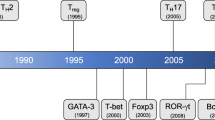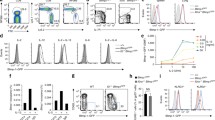Abstract
After activation, CD4 helper T (Th) cells differentiate into Th1 or Th2 effector cells. These two subsets produce distinct profiles of cytokines and regulate different immune responses. Here we discuss transcription factors and signaling pathways that are selectively expressed or activated in Th1 and Th2 cells to regulate cytokine gene expression, cell proliferation and apoptosis.
Similar content being viewed by others
References
Mosmann TR, Coffinan RL. Th1 and Th2 cells: different patterns of lymphokine secretion lead to different functional properties. Annu Rev Immunol 1989; 7: 145–73.
Zheng W-P, Flavell RA. The transcription factor GATA-3 is necessary and sufficient for Th2 gene expression in CD4* T cells. Cell 1997; 89: 587–96.
Zhang DH, Cohn L, Ray P, Bottomry K, Ray A. Transcriptional factor GATA-3 is differentially expressed in murine Thl and Th2 cells and controls Th2-specific expression of the interleukin-5 gene. J Biol Chem 1997; 272: 21597–603.
Ouyang W, Ranganath SH, Weindel K, Bhattacharya D, Murphy TL, Sha WC et al. Inhibition of Thl development mediated by GATA-3 through an IL-4-independent mechanism. Immunity 1998; 9: 745–55.
Zhang D-H, Yang L, Cohn L, Parkyn L, Homer R, Ray P et al. Inhibition of allergic inflammation in a murine model of asthma by expression of a dominant-negative mutant of GATA-3. Immunity 1999; 11:473–82.
Ouyang W, Lohning M, Gao Z, Assenmacher M, Ranganath S, Radbruch A et al. Stat6-independent GATA-3 autoactivation directs IL-4-independent Th2 development and commitment. Immunity 2000; 12: 27–37.
Li B, Tournier C, Davis RJ, Flavell RA. Regulation of T helper cell differentiation by the transcription factor JunB. EMBO J 1999; 19: 420–32.
Ho IC, Hodge MR, Rooney JW, Glimcher LH. The proto-oncogene c-maf is responsible for tissue-specific expression of interleukin-4. Cell 1996; 85: 973–83.
Ho IC, Lo D, Glimcher LH. C-maf promotes T helper cell type 2 (Th2) and attenuates Thl differentiation by both interleukin 4-dependent and -independent mechanisms. J Exp Med 1998; 188: 1859–66.
Kim JI, Ho IC, Grusby MJ, Glimcher LH. The transcription factor c-Maf controls the production of interleukin-4 but not other Th2 cytokines. Immunity 1999; 10: 745–51.
Szabo SJ, Kim ST, Costa GL, Zhang X, Fathman CG, Glimcher LH. A novel transcription factor, T-bet, directs Thl lineage commitment Cell 2000; 100: 655–69.
Rincón M, Enslen H, Raingeaud J, Recht M, Zapton T, Su MS-S et al. Interferon-γ expression by Thl effector T cells mediated by the p38 MAP kinase signaling pathway. EMBO J 1998; 17: 2817–29.
Lu H-T, Yang DD, Wysk M, Gatti E, Mellman I, Davis RJ et al. Defective IL-12 production in mitogen-activated protein (MAP) kinase kinase 3 (Mkk3)-deficient mice. EMBO J 1999; 18:1845–57.
Penix L, Weaver WM, Pang Y, Young HA, Wilson CB. Two essential regulatory elements in the human interferon gamma promoter confer activation specific expression in T cells. J Exp Med 1993; 178: 1483–96.
Penix LA, Sweetser MT, Weaver WM, Hoey T, Hoeffler JP, Kerpolla TK et al. The proximal regulatory element of the interferon-y promoter mediates selective expression in T cells. J Biol Chem 1996; 271: 31964–72.
Zhang F, Wang DZ, Boothby M, Penix LA, Flavell RA, Aune TM. Regulation of the activity of IFNy promoter elements during Th cell differentiation. J Immunol 1998; 161: 6105–12.
Aune TM, Penix LA, Rincón M, Flavell RA. Memory and effector, but not naive t cells, express transcriptional activity under the control of two IFNγpromoter elements. Mol Cell Biol 1997; 17: 199–204.
Weiss L, Whitmarsh AJ, Yang DD, Rincon M, Davis RJ, Flavell RA. Regulation of c-Jun NH(2)-terminal kinase (Jnk) gene expression during T cell activation. J Exp Med 2000; 191: 139–46.
Yang D, Conze D, Whitmarsh AJ, Barrett T, Davis RJ, Rincon M et al. Differentiation of CD4+ T cells to Thl cells requires MAP kinase JNK2. Immunity 1998; 9: 575–85.
Dong C, Yang DD, Wysk M, Whitmarsh AJ, Davis RJ, Flavell RA. Defective t cell differentiation in the absence of Jnk1. Science 1998; 282: 2092–95.
Dong C, Yang D, Tournier C, Whitmarsh A, Xu J, Davis R et al. JNK is required for effector T-cell function but not for T-cell activation. Nature 2000; 405: 91–4.
Chow C-W, Dong C, Flavell R, Davis R. JNK inhibits targeting of protein phosphatase calcineurin to NFATcl. Mol Cell Biol 2000; 20: 5227–34.
Li B, Yu H, Zheng W-P, Voll R, Na S, Roberts A et al. Role of the Guanosine Triphosphatase Rac2 in T helper 1 cell differentiation. Science 2000; 288: 2219–22.
Lu B, Yu H, Chow C-w, Li B, Zheng W-p, Davis RJ, Flavell RA. GADD45y mediates the requirement of the p38 and JNK MAP kinase pathways and cytokine production in effector Thl cells. Immunity 2001, 14: 583–90.
Rincón, M, Yang D, Whitmarsh A, Weiss L, Dérijard B, Jayaraj P et al. The JNK pathway regulates thein vivo deletion of immature CD4+CD8+ thymocytes. J Exp Med 1998; 188: 1817–30.
Yang DD, Kuan C-Y, Whitmarsh AJ, Rincón M, Zheng TS, Davis RJ et al. Absence of excitotoxicity-induced apoptosis in the hippocampus of mice lacking the Jnk3 gene. Nature 1997; 389: 865–70.
Tournier C, Hess P, Yang DD, Xu J, Turner TK, Nimnual A et al. Requirement of JNK for stress-induced activation of the cytochrome C-mediated death pathway. Science 2000; 288: 870–4.
Author information
Authors and Affiliations
Corresponding author
Additional information
An erratum to this article can be found at http://dx.doi.org/10.1007/s00011-012-0525-8
Rights and permissions
About this article
Cite this article
Flavell, R.A., Dong, C. & Davis, R.J. Signaling and cell death in lymphocytes. Inflamm Res 51, 80–82 (2002). https://doi.org/10.1007/BF02684006
Published:
Issue Date:
DOI: https://doi.org/10.1007/BF02684006




